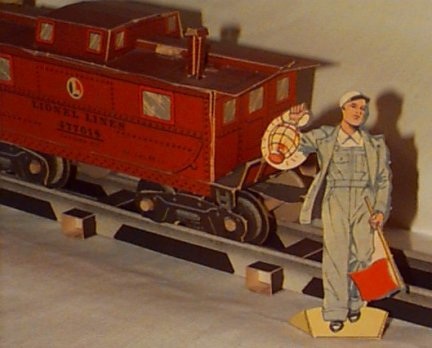When I assigned “The Best Job I Ever Had” as a topic for the writers in my memoir classes, Hugh went home and started making a list. “I wrote down every place I’d ever worked,” he said. “This one kept coming up on top.”
His essay opens in the summer of 1943. Hugh was 11 years old, American soldiers were fighting in World War II, and everyone here at home was rationing. “Metal was necessary to use in making all kinds of military equipment,” he wrote, describing scrap metal drives, manufacturers of pots and pans switching to making mess kits for soldiers, Boy Scouts collecting tin cans that would eventually be turned into airplanes.
Less important businesses like toy manufacturers had to stop using metal altogether, and Hugh said it hit the Lionel Train company hard. ”They knew they wouldn’t be able to sell any new electric trains to run around the Christmas Trees.” What to do? Execs at Lionel put their heads together and hired a novelty designer who came up with the answer: paper trains. From Hugh’s essay:
My mother worked for a market research firm that was hired to test whether the paper trains were easy enough to assemble and to produce enough samples to show to the retail stores. Mom, in turn, enlisted my 14-year-old brother and some of his friends to assemble a bunch of paper trains. Needless to say, although I was only 11, I tagged along and got hired, too.
Hugh describes the flat 11×15 lightweight cardboard sheets he and his buddies worked with: each sheet had train parts printed in authentic colors, and Lionel’s insignia was on every page. “The kit included an engine, a tender, a boxcar, a gondola car and a caboose,” Hugh said, stopping to take a breath before continuing to read his essay out loud in class. “It also had a crossing gate, a crossing signal and enough paper ties and rails to make a good sized circle.” The wheels were laminated cardboard, too, but the axles were little rods made of wood. “It took us many tries to be able to assemble the cars and the track, but eventually we became pretty good.”
It was difficult to find any information online about these 1943 paper trains, and I might have started worrying about Hugh if I hadn’t found a Lionel Wartime Freight Train page on Wikipedia. The Wikipedia page confirmed Hugh’s story and reported that paper trains did well financially in 1943. After buying a paper train for their children, though, most parents became so frustrated by the assembly process that they gave up on putting it together and threw it out.
Hugh and his buddies got paid for testing the paper trains ahead of time, but he couldn’t remember how much they earned for their work. “It must have been by the hour,” he wrote, realizing now that if it was by the piece, they wrecked so many that they never would have made anything.
”It was really fun being with our friends and playing at putting these things together,” Hugh wrote. “And I got paid!” The all-paper product train sold for a dollar during the 1943 Christmas season, but it went off the market after that due to poor customer response. Seventy years (and many, many jobs) later, however, Hugh maintains that getting paid to put those paper trains together “is still The Best Job I Ever Had.”

Hugh, That’s really a great story.
Myrna
Thanks, Myrna…It’s one of those classic memories that get buried until one of Beth’s assignment/suggestions pop it up again. Best..Hugh
I’d like a job like that right now. Where do I sign up?!
I certainly never knew about the paper trains in 1943. My older brother and I had a modest Lionel train and town set up in our “train” room located in the basement of our house. We always thought Lionel was the best of the model trains but a paper imitation? A fun story.
Thanks, Brad….My brother and I also had a regular train layout before and after the paper train experience. I have a good friend who’s 80 and is still keeping up and periodically adding to or rearranging his layout ! What is there about electric trains that’s so appealing ? A sense of power and control ? Oooops, let’s not over-analyze it !
Best, H
What a fun, unique job! If any of these still exist, they must be quite collectable and worth $$!
I think I saw that one sold a couple of years ago on e-bay for $125…..and it sounded like some parts were missing from the set and some parts were not in very good condition…..the sets and the trains were certainly not “built to last” !! But it would be fun to have one now !
…and I am pretty confident that if you still had one, Hugh, you wouldn’t sell it at any cost!
_____
What a fabulous memory! I wonder how many obscure product variants we never knew of came from the rationing of WWI and WWII?
This reminded me of my first ‘paying’ job when I was 9 or so, filing my uncle’s paperwork for his job as an electrical engineer….a half-eon ago! Started out at something like .25 or .50 cents/hour.
But Hugh’s paper trains sound like fun!
You must have been a pretty smart little girl, Deborah, doing that sort of work at age nine!
_____
[…] two writers in one class came back with essays about jobs they had when they were 11 years old. Last week’s post featured excerpts from Hugh’s essay about putting paper Trains together in 1942, and today I’m sharing excerpts from the piece his […]
Leave a Response